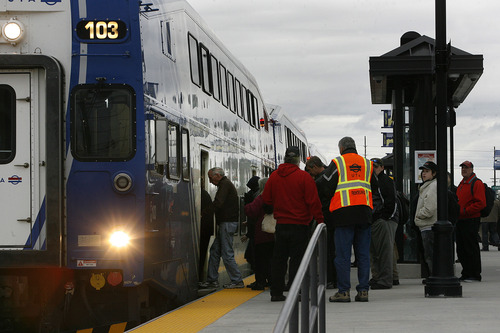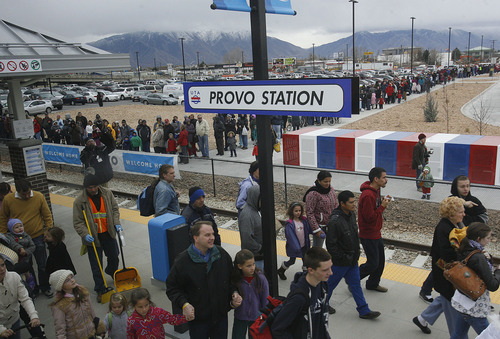This is an archived article that was published on sltrib.com in 2012, and information in the article may be outdated. It is provided only for personal research purposes and may not be reprinted.
Crowds riding the new FrontRunner extension between Salt Lake City and Provo had their experience derailed by a variety of foul-ups and delays in its first couple days of operation.
Problems included vending machines that would not dispense tickets, promised Wi-Fi Internet access sometimes not functioning, confusion about which side of platforms trains would arrive at and slow-loading crowds and mechanical breakdowns creating delays.
Social networks also carry plenty of griping from some Utah County riders who have longer commutes than they did with now-canceled express buses and from some FrontRunner North and TRAX riders who have somewhat-reduced service to help pay for the new FrontRunner South.
But the new rail line also has its cheering fans.
"We've had some growing pains," acknowledged Utah Transit Authority spokesman Gerry Carpenter. "There is always a settling-in period with a new line. We apologize to our customers for the inconvenience and ask for their patience."
An example of problems as the new line opened Monday was that ticket vending machines quit accepting credit cards for payment. A station in South Jordan lost power, so ticket machines there did not work at all. Carpenter said problems were resolved, and transit police allowed people to ride without tickets because of problems.
He said another problem is that the many new passengers using the line "are taking longer to board than typical," and operators were "exercising extra caution as they approached the new stations." That led to peak-hour delays of seven to eight minutes on most trains, and some delays of 15 minutes or more.
"Hopefully, over the next couple days, the customers and our operators will get used to how the new system works," Carpenter said, "and we'll be able to stay closer to our posted schedule."
On Tuesday, a train broke down in Kaysville in a section where only a single track is used. It had to be towed to Layton, and the ripple effect created long delays in all FrontRunner sections for hours.
"You do all the testing you can to make sure everything is working in functional order," Carpenter said, "but the real test is when passengers start using it."
Twitter posts showed some confusion among riders about which side of platforms trains would arrive — because it is opposite from most TRAX stations. FrontRunner's southbound trains use the east side of platforms, and northbound trains use the west side. UTA Twitter posts noted that is standard for most heavy rail lines and said it will work to improve signs to make that clearer.
Matthew Fitton filed a Twitter post typical of many Utah County residents complaining about longer commutes on FrontRunner than on former express buses. "You guys almost doubled my commute, 60 minutes to 110," he wrote. "I bought my house for proximity to bus and you took it away. ... I'm driving now."
Carpenter said while FrontRunner now makes many former express bus riders transfer, increasing their commute times, the train can carry far more passengers than buses. "We believe we will carry many more people between counties on FrontRunner than we ever have been able to do with express buses, and it is also an investment for the future."
Some FrontRunner North riders complained that service every 30 minutes is now limited to peak hours, and even some peak-hour trains disappeared. D. Young posted on Twitter: "Would've enjoyed riding the train today but you removed the morning route that would get me to work on time," the northbound train from Clearfield at 6:01 a.m.
And some complained about cuts in TRAX to help afford other service. That includes starting TRAX an hour later on Saturdays (the first blue-line train departs Sandy Civic Center at 6:36 a.m.), and ending Sunday service 90 minutes to two hours earlier (the last train now leaves Salt Lake City Central Station at 8:12 p.m.).
"I spent $50 in the taxi because no TRAX at 9 p.m." on Sunday, Daniel Lopez Garcia posted on Twitter. He said he was aware that ending times were earlier and he arrived on time, but he and others were left waiting for a train that never came.
Still, amid the glitches, several people expressed glee at the new FrontRunner. For example, Katie Farr Harmer tweeted, "Dear UTA, the FrontRunner is awesome. Makes my commute 100 [times] easier."
Carpenter said "very preliminary" estimates show 6,700 people rode FrontRunner South on Monday, about matching the 6,800 a day that UTA has estimated would ride it daily at opening. He said the figures could be revised upward as data is examined. —
Crowds flocked to free fare day
During a "food for fare" offer Saturday, 32,300 people rode the new FrontRunner South extension to Provo. That is about five times the 6,800 riders expected on a normal weekday.
Utah Transit Authority spokesman Gerry Carpenter said waits were up to two hours to board a train in Provo, and all trains were full including use of all standing-room-only space. UTA even brought in buses so people waiting in line could get out of the cold.
Carpenter said 25,324 pounds of nonperishable food items for food banks were collected in lieu of fares that day.







